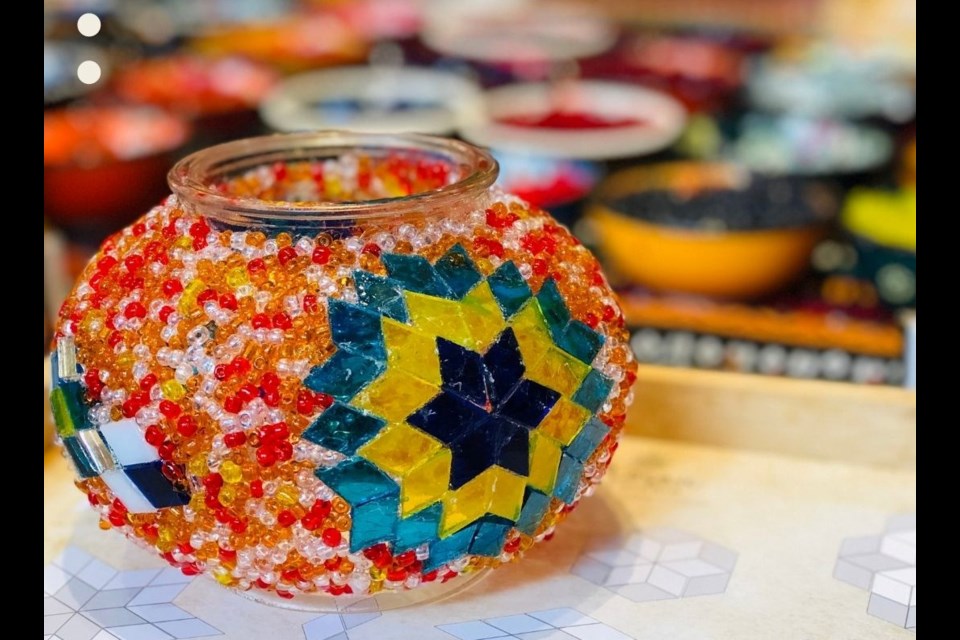Adam Ucar, Ekrem Tapan and Halil Gozukara first met as students in Hong Kong. Ucar was studying law, Tapan, IT, and Gozukara, international relations.
All three, who had grown up in Turkey, had moved to Hong Kong for higher studies. Here, while they acclimatized to the new culture by learning Mandarin, they wanted to introduce others to their culture too.
To do so, they turned to a simple everyday object they used in their homes: a mosaic lamp.
“It [the mosaic lamp] is very common for our eyes, actually. Every Turkish kid has seen it,” said Ucar, who recalls having two dim swan lamps in the bedroom, and a bright table lamp in the living room, at the house he grew up in.
The three friends decided to hold a small workshop teaching others how to create the mosaic art pattern they were so familiar with.
They never thought of it as a long-term business until the workshop became a hit, and someone came up to them and asked, “Can I buy a lamp?”
That was enough of a push for them to start their first store in Hong Kong. In fact, Ucar, who had gotten a white-collar job after graduation, decided to give it up so that he could teach and sell mosaic art.
Now, their studio has branches in Hong Kong, Taiwan, Netherlands and Canada.
Bringing mosaic art to New West
Since the opening of their store in downtown New Westminster in January 2022, they have already had more than 2,000 lamps made at their workshops.
People from all across the country, sometimes even the United States, show up. Some corporate companies bring their employees for team-building workshops; many to-be-brides prefer DIY mosaic lamp workshops as part of their bridal showers, said Ucar.
They hadn’t expected the overwhelming response.
On a Friday evening, this reporter headed to their studio at 332 Columbia St. to see what the buzz was about.
A flight of dimly lit, winding stairs led to a bright room filled with rows and rows of glittering mosaic lamps. Heavy chandeliers hung from the ceiling, colourful rugs were laid out on the floors, and slow classical Turkish music played in the background.
“We wanted to create a small space where people can experience the rich culture of Istanbul without having to fly all the way there,” said Ucar, inviting this reporter to sit at a table on which rested 50 small ceramic bowls of different coloured mosaic pieces imported from Turkey.
The pieces, smooth to touch and with blunt corners, were made by a senior craftsman — Ucar’s mosaic art teacher, who runs a store in the historic Grand Bazaar in Istanbul.
Besides the shimmery cut-glass pieces and beads, there was a bottle of glue (to stick the mosaic pieces on to the lamp), a tweezer (to place the beads carefully), and a sheet with traditional mosaic patterns that people could refer to while designing their lamp.
Even as Ucar, who is an advanced mosaic artist, demonstrated the technique, his friend and co-founder Tapan offered a tray of Turkish tea and treats —imported from their home town.
The history of Turkish mosaic art
While this reporter washed down a savoury sesame cookie with a swig of strong black tea, Ucar talked about the evolution of mosaic art in Turkey. “It came about close to 6,000 years ago.”
Turkey’s art has been influenced by the presence of the Greek-speaking Byzantine or Eastern Roman empire that ruled between the fourth and 14th centuries — during this period, mosaics of Christian religious figures and powerful rulers were popular, as mentioned on the Khan Academy website.
The rule of the Ottoman empire began in the 1450s (via National Geographic); and with that shift in power, nature-inspired mosaic patterns began to appear in mosques, as mentioned in ceramic artist and educator George Woideck’s blog.
As per Ucar, who hesitantly admits to scraping mosaic pieces off neighbour’s walls as a kid, the practice of pasting mosaics on walls came from the Greeks; using it on lamps was an idea brought later by the Ottomans.
Though it's a significant part of Turkey's art and culture, those from the region see it as just another functional piece — a source of light when it gets dark. In fact, Ucar's family is surprised that he runs a successful business around them.
“My older brother still can't believe I'm making these for profit,” he said with a laugh.
“He thinks it’s only a lamp.”
But Ucar, his friends and the 2,500-odd people who spent hours learning the art at the studio know that it's much more than that.
Mosaic Art Studio at 332 Columbia St. offers workshops all week except Monday and Thursday. A two-hour workshop is priced at $69.




